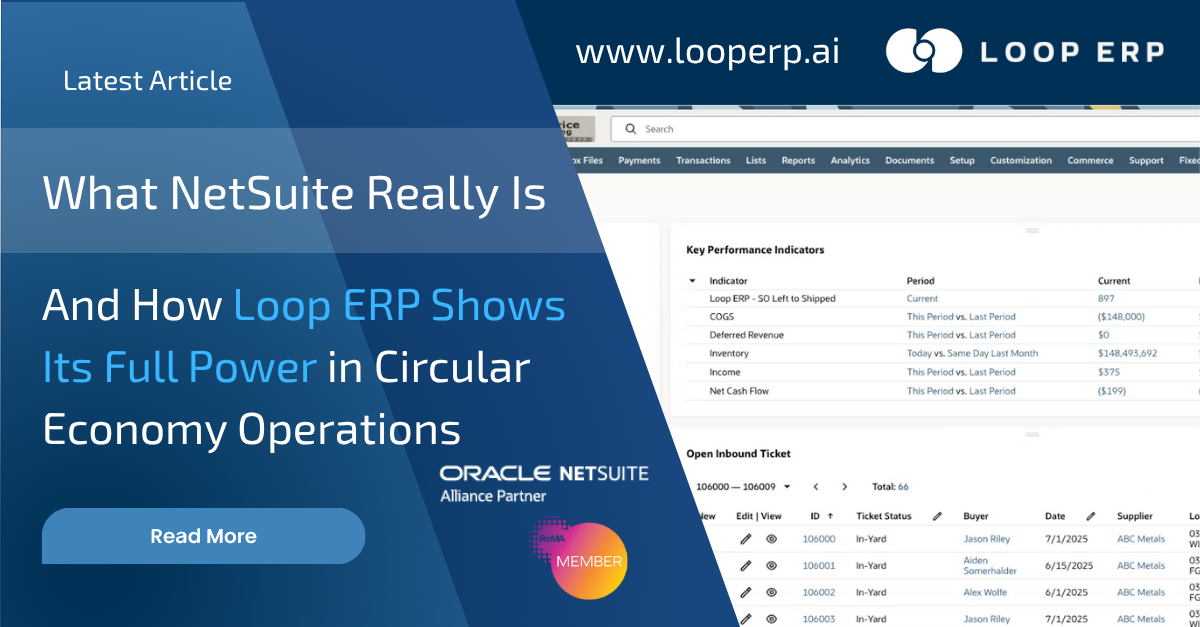
For scrap metal, waste management and aggregate supply companies, your business literally lives and dies by the scale. Every ton, every kilogram, every pound directly impacts your bottom line. Yet many operations continue to rely on disconnected weighing systems and manual data entry, creating a cascade of hidden costs that silently erode profitability day after day.
What's the real cost of a 1% weighing discrepancy? For many commodity transformation businesses, it's far more significant than most realize.
Consider a mid-sized scrap metal processor handling 200 tons of material daily. With metal values averaging $300 per ton, a mere 1% weighing inaccuracy represents 2 tons of "phantom inventory" each day - translating to $600 in daily revenue impact, or over $150,000 annually.
This seemingly minor discrepancy compounds throughout your operation in several critical ways:
Inaccurate incoming weights frequently lead to overpaying suppliers for materials that were never actually received. When scale readings are consistently high by even small percentages, you're essentially paying for phantom tonnage. For businesses processing hundreds or thousands of tons weekly, these overpayments silently drain working capital and directly reduce margins on every processed load. Many operations discover they've been overpaying suppliers for years before implementing integrated weighbridge systems.
When weighing inaccuracies persist, physical inventory never truly reconciles with system records. This creates a perpetual mismatch between what your ERP says you have and what actually exists in your yards or warehouses. Accounting teams often resort to regular "inventory adjustments" that mask the underlying problem rather than solving it. Beyond the financial implications, this distortion makes production planning unreliable and undermines management's ability to make informed decisions based on inventory positions.

Resource allocation based on incorrect weight data leads to significant processing inefficiencies. When equipment is scheduled and staffed for volumes that don't actually exist, you're paying for labor, energy, and equipment time that generates no corresponding revenue. Conversely, underestimated weights can lead to production bottlenecks and missed shipping commitments. Either scenario results in suboptimal resource utilization that directly impacts operational profitability.
Weight discrepancies inevitably lead to customer disputes that damage hard-earned relationships and trust. When outgoing shipments consistently weigh differently at customer locations than at your facility, it creates friction with every transaction. These disputes not only consume valuable administrative time but often result in price adjustments and credits that further erode margins. In worst cases, persistent discrepancies can cost you customers entirely as they seek more reliable suppliers.
Without accurate weight tracking through processing stages, operations remain unable to pinpoint where material loss occurs. Every commodity transformation process has expected yield rates, but without precise weighing at critical control points, it's impossible to identify where recoverable material is being lost. These missed recovery opportunities represent some of the most significant hidden costs, as valuable commodities literally disappear from your value chain without detection.
In scrap metal, aggregate and quarry operations, the impact can be even more pronounced. When your product literally sells by weight, scale accuracy directly correlates to revenue recognition. In an industry where net margins often hover between 5-10%, weighing discrepancies can make the difference between profitability and loss.
"In industries where revenue is directly tied to weight, even a small discrepancy can lead to significant financial losses. Accurate weighing systems are essential for profitability and operational efficiency."
Beyond mechanical calibration issues, manual data entry introduces significant risks into weighbridge operations. Research has consistently shown that manual data entry error rates typically range between 1-4%, regardless of operator experience or attention to detail. In high-volume weighbridge operations, this translates to dozens of potentially erroneous transactions daily.
Each manual entry represents multiple risk points that compromise data integrity:
Swapped digits represent one of the most common and difficult-to-detect data entry errors in weighbridge operations. When an operator enters 1498 instead of 1489, the 9-unit difference might seem insignificant at first glance. However, when dealing with high-value commodities, these transpositions can represent significant financial discrepancies. What makes these errors particularly problematic is their randomness - they don't follow patterns that can be easily identified through systematic checks, making them persistent drains on accuracy.
Difficulty reading handwritten information on scale tickets creates a constant source of data corruption. Despite technological advances, many operations still rely on handwritten information for driver identification, material sources, or special handling instructions. Operators faced with interpreting hastily scribbled notes make educated guesses that often introduce errors into the system. These misinterpretations can lead to materials being classified incorrectly, attributed to the wrong suppliers, or directed to inappropriate processing streams.
Incorrect material type selection during manual entry can have far-reaching implications throughout the processing chain. When an operator miscategorizes incoming material - selecting "aluminum scrap" instead of "aluminum turnings," for instance - it initiates a cascade of problems. The material may be directed to inappropriate processing equipment, valued incorrectly in inventory, and ultimately sold at inappropriate pricing. These classification errors distort commodity-specific performance metrics and undermine process optimization efforts.
These errors don't just impact individual transactions - they create persistent data integrity issues that undermine operational intelligence and strategic decision-making.
Forward-thinking commodity transformation businesses are eliminating these risks through comprehensive weighbridge integration with their ERP systems. Unlike standalone scales or partially connected systems, true integration creates a seamless data flow that transforms weighing from a potential liability into a strategic advantage.
Loop ERP's weighbridge integration represents the industry benchmark, offering:
Modern integrated weighbridge systems enable weight data to flow directly into the ERP without human intervention, creating an unbroken digital chain from the physical scale to your business systems. This automation eliminates the time lag and error potential inherent in manual processes. As vehicles cross the scale, weight data combines with RFID identification, camera systems, and digital signatures to create complete transaction records instantaneously. This real-time capture ensures that your business decisions are based on current reality rather than delayed and potentially distorted data entries.
Entry and exit weights are automatically compared against expected processing outcomes, creating a closed-loop verification system that validates material movements. This capability is particularly valuable in commodity transformation operations where materials change form between entry and exit weighing. The system automatically calculates expected output weights based on material types and processing parameters, then flags transactions that fall outside acceptable variance thresholds. This verification creates accountability throughout the processing chain and quickly identifies anomalies that merit investigation.
Advanced scale systems incorporate material classification intelligence that understands your specific grading requirements. Rather than relying on operators to visually assess and manually classify incoming materials, integrated systems can incorporate imaging technology, density calculations, and historical supplier patterns to suggest or verify classifications. This integration ensures that materials are properly categorized from the moment they enter your facility, eliminating downstream corrections and adjustments that plague manual classification processes.
Daily variance reporting automatically flags potential issues before they compound into significant problems. The system continuously compares actual weights against expected process outcomes, generating exception reports that highlight discrepancies requiring investigation. This early detection capability transforms reconciliation from a monthly crisis management exercise to a daily continuous improvement process. Operations can address small variances immediately rather than attempting to reconstruct what happened weeks after the fact.
Integrated weighbridge systems establish complete traceability from receipt through processing and shipment, meeting increasingly stringent regulatory and customer requirements. Every material movement is documented with timestamps, locations, handling personnel, and weight changes. This comprehensive chain-of-custody creates defensible documentation for environmental compliance, quality certifications, and customer verification. For operations handling regulated materials or serving highly regulated industries, this traceability transforms compliance from a burdensome requirement to an automated byproduct of normal operations.
This level of integration eliminates the data silos that plague many operations, where scale systems operate independently from inventory management and financial systems.
For businesses that transform commodities through processing, the value of integration extends far beyond basic weight capture. True weighbridge integration enables tracking material transformations through multiple processing stages, providing unprecedented visibility into:
Integrated weighbridge systems provide unprecedented visibility into actual recovery percentages across different material streams, enabling data-driven optimization of processing parameters. When you can precisely measure input and output weights at each processing stage, you gain the ability to experiment with different equipment settings and immediately quantify the yield impact. This visibility transforms yield optimization from periodic spot-checks to continuous improvement. Companies utilizing this capability regularly identify yield improvements of 2-5% in existing processes - value that previously disappeared as unrecovered material.
Comparative performance analysis between equipment lines or operating shifts becomes possible only with accurate weight-based tracking through each process stage. Integrated weighbridge data reveals which production lines consistently achieve higher recovery rates and which shifts maintain better processing efficiency. This benchmarking capability enables operations to identify and replicate best practices across the organization. Rather than relying on subjective assessments, management can make decisions based on objective performance metrics tied directly to material movements and transformations.
Pinpointing exactly where material loss occurs within complex processes represents one of the most valuable capabilities of integrated weighbridge systems. By establishing weighing points at critical process transitions, operations can isolate exactly where expected material isn't reaching the next stage. This precise identification allows maintenance and engineering teams to focus their efforts on specific transfer points, dust collection systems, or processing equipment where material is being lost. For many operations, this capability alone justifies weighbridge integration investment through recovered material value.
Connecting incoming material attributes to finished product quality becomes possible when weight data integrates with quality testing results. This correlation analysis helps operations understand exactly how variations in input materials affect final product specifications. For example, a concrete aggregate producer might discover that materials from a specific quarry source consistently yield higher-strength concrete despite appearing visually identical to other sources. This intelligence enables both better supplier management and more precise blending strategies to maintain consistent quality standards.
Automated documentation of diversion rates and recovery percentages significantly simplifies regulatory reporting requirements that continue to become more stringent each year. For operations subject to recycling rate mandates, landfill diversion requirements, or producer responsibility regulations, integrated weighbridge data provides defensible documentation of environmental performance. Rather than laboriously reconstructing material flows from disconnected records, compliance reports can be generated automatically with complete supporting documentation. This capability not only reduces administrative burden but also minimizes compliance risk through more accurate and consistent reporting.
This transformation visibility creates opportunities for process optimization that were previously impossible with disconnected systems. When you can accurately track what happens between incoming and outgoing weights, you gain actionable intelligence that directly impacts profitability.
While eliminating weight discrepancies creates immediate financial benefits, the return on weighbridge integration extends far beyond these direct savings:
Accurate weight-based data fundamentally transforms decision-making throughout commodity transformation businesses. When management can trust inventory figures and material movement data, it enables more strategic purchasing decisions based on actual processing capacity and yield expectations. Sales teams can confidently make commitments knowing exactly what materials are available and when new production will be complete. Capital investment decisions become more targeted as the data clearly shows which process areas truly need capacity enhancement. This data-driven management approach replaces intuition and experience-based guessing with objective analysis of actual material flows and transformations.
Precise material tracking enables dramatically more efficient resource allocation across operations. Labor scheduling improves as staffing aligns with actual material processing requirements rather than estimates. Equipment utilization increases as unnecessary idling is eliminated through better production planning. Energy consumption decreases as processes run at optimal capacities rather than underutilized or overloaded conditions. Even consumable supplies become more efficiently managed as usage rates correlate directly with actual material processed. This comprehensive resource optimization often delivers cost reductions that exceed the direct savings from eliminated weight discrepancies.
Comprehensive weight documentation dramatically reduces supplier and customer conflicts by providing indisputable transaction evidence. When disagreements arise about delivered quantities or quality specifications, integrated weighbridge data provides timestamped proof of exactly what materials entered or left your facility. Photo documentation integrated with weight records further strengthens your position in disputes. Many operations report that after implementing integrated weighbridge systems, the number of transaction disputes decreases by 80% or more, and the time required to resolve remaining disputes drops significantly as objective evidence replaces conflicting recollections.
Automated record-keeping transforms compliance from a burdensome manual process to an integrated aspect of normal operations. Environmental reporting becomes simpler as material diversion rates and processing volumes are automatically calculated from verified weight data. Trade certification requirements for selling into regulated markets are satisfied through comprehensive chain-of-custody documentation. Transportation compliance improves as vehicle weights are precisely recorded and compared against legal limits. For operations in highly regulated sectors, this compliance simplification often represents one of the most immediate and visible benefits of weighbridge integration.
Detailed transformation data becomes the foundation for continuous improvement initiatives that drive long-term competitive advantage. When you can precisely measure what happens to materials at each process stage, you can experiment with new techniques and immediately quantify the results. Process engineers can focus on areas with the greatest improvement potential rather than making educated guesses. Supplier quality programs become more effective as you correlate incoming material characteristics with processing outcomes. This continuous improvement capability transforms operations from static processes to dynamic systems that constantly evolve toward higher efficiency and recovery rates.
For most commodity transformation businesses, these strategic benefits deliver greater value than the direct savings from eliminated discrepancies.
For commodity transformation businesses, integrated weighbridge systems have evolved from optional technology to essential strategic infrastructure. As material costs rise and margins tighten, the businesses that thrive will be those that eliminate the hidden costs of disconnected weighing systems.
Loop ERP's purpose-built weighbridge integration represents the industry's most comprehensive solution for scrap, waste, and aggregate operations. By eliminating manual entry, connecting weight data with processing activities, and providing transaction-level visibility, Loop transforms weighbridge operations from potential liability to strategic advantage.
The question is no longer whether your business can afford integrated weighbridge systems, but whether it can afford to operate without them.
Learn more about Loop ERP's weighbridge integration capabilities by contacting our industry specialists or requesting a personalized demonstration focused on your specific commodity transformation requirements.
Powerful, self-serve product and growth analytics to help you convert, engage.
Blogs

December 4, 2025
The Best ERP System for Aggregate Operations, Built for How Your Business Actually Works

November 18, 2025
What NetSuite Really Is, And How Loop ERP Shows Its Full Power in Circular Economy Operations

November 7, 2025
Webinar: Connecting Operations and Finance with Loop ERP: The Scrap Recycling ERP Built for Real Business